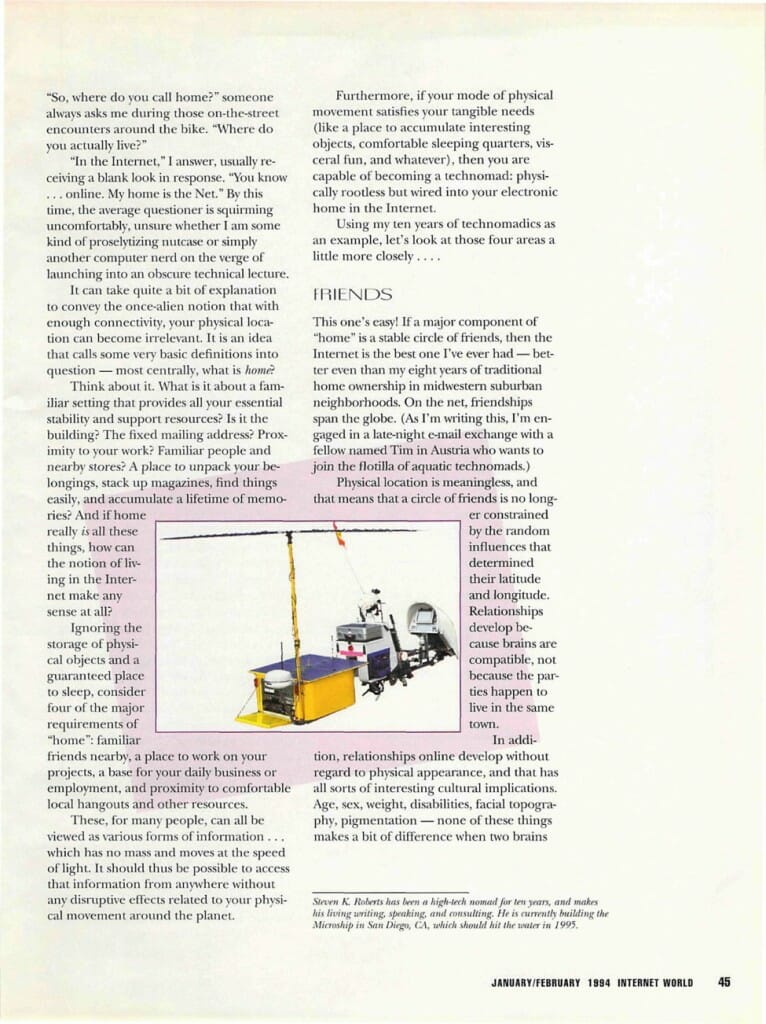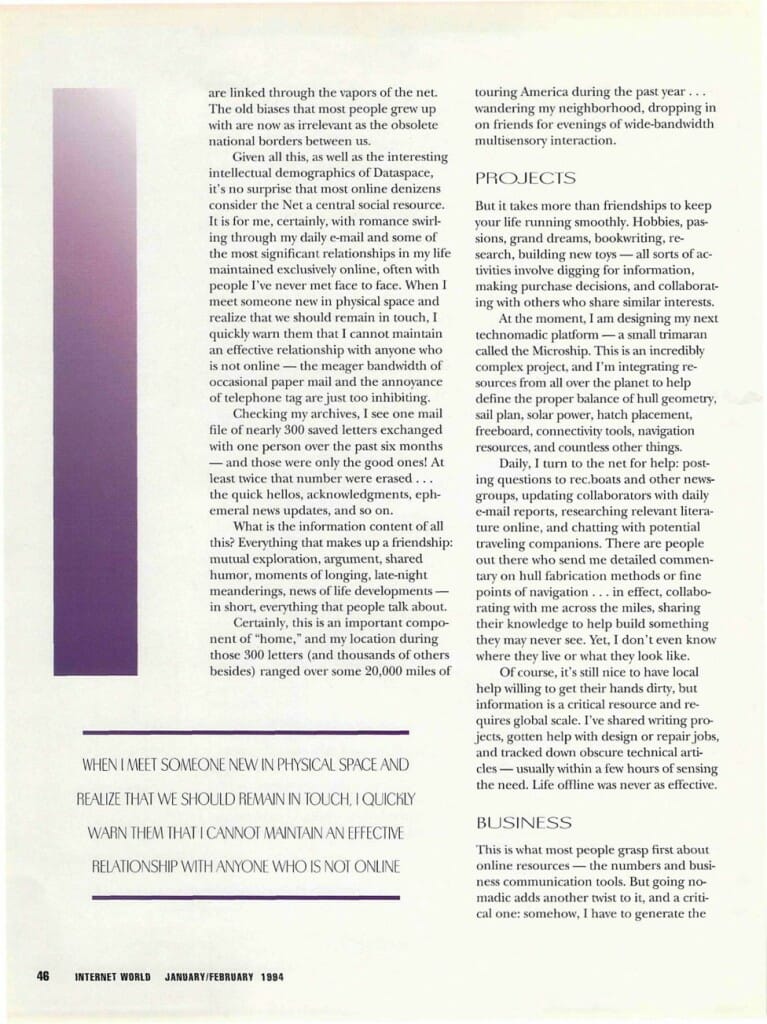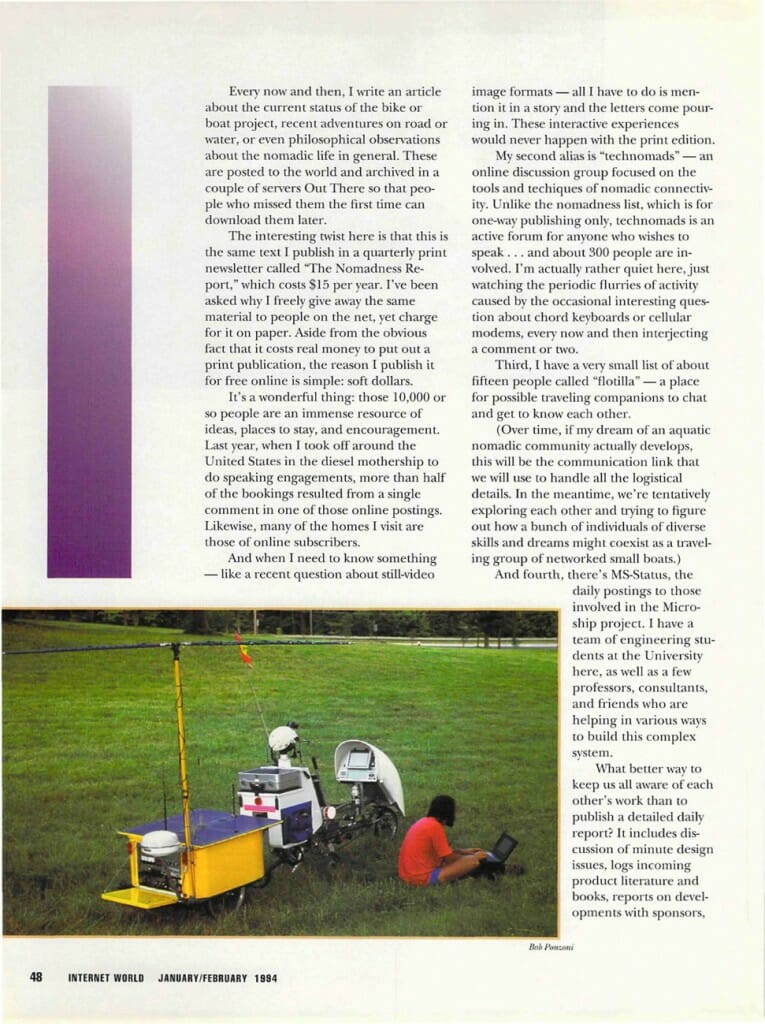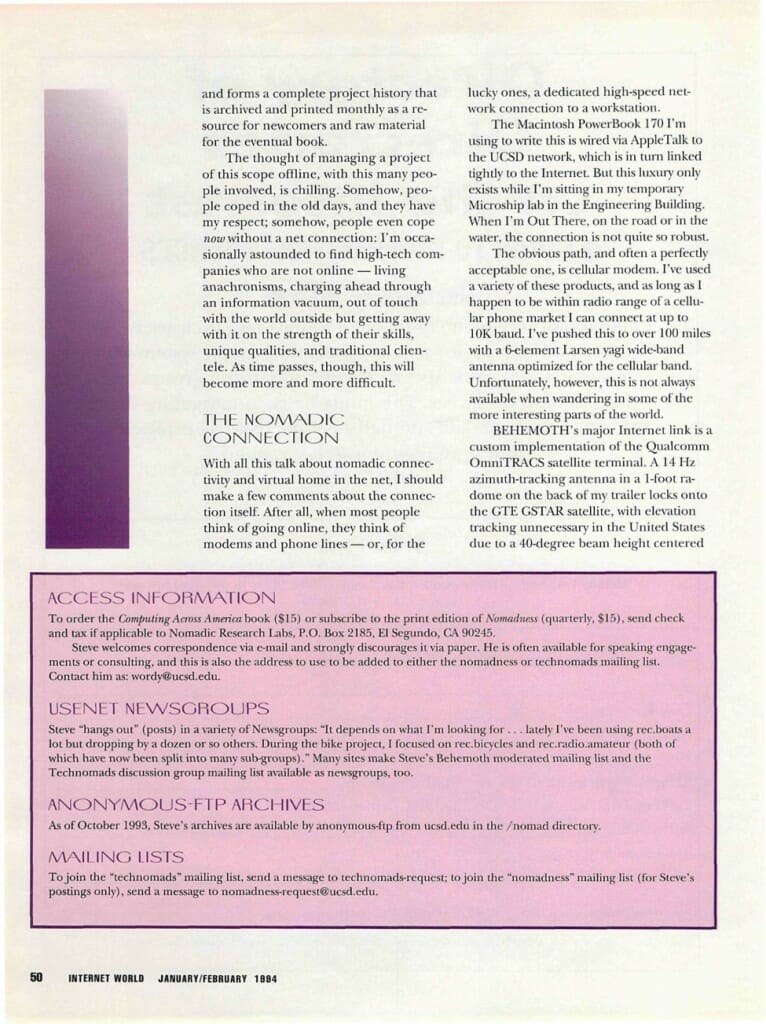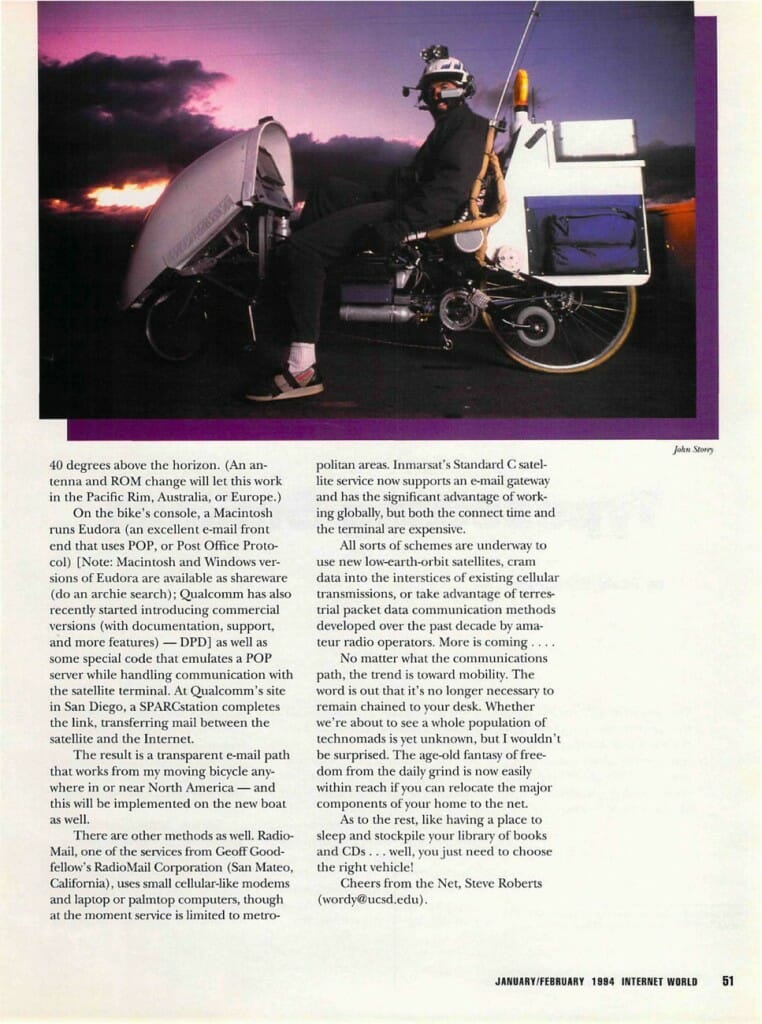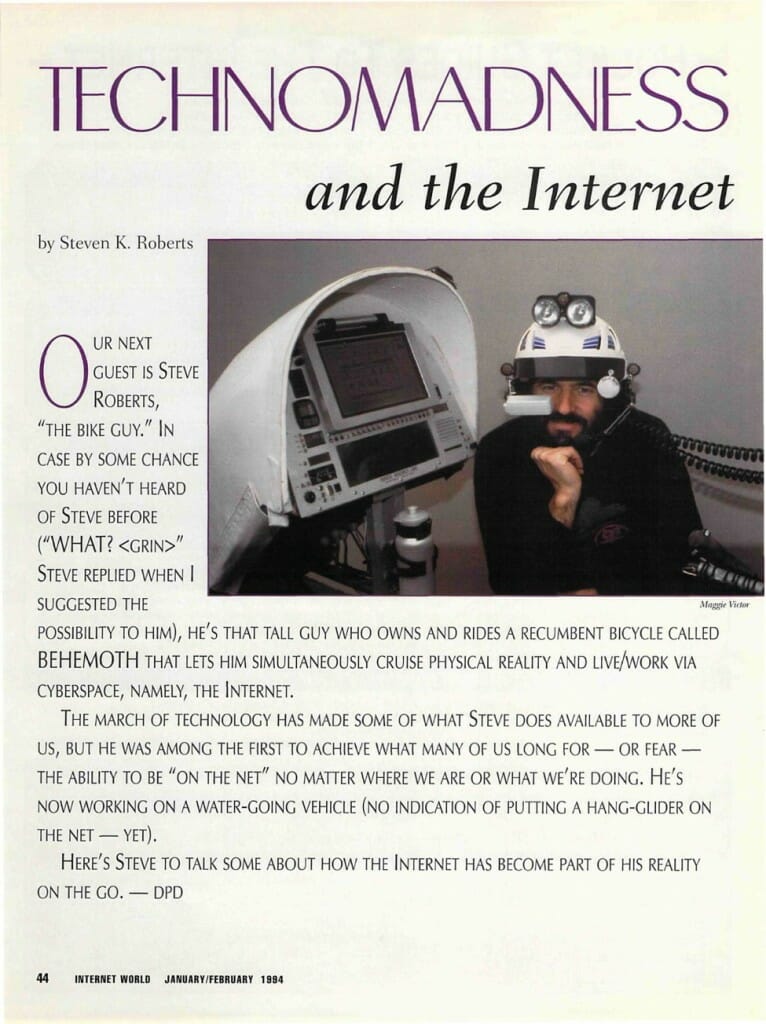
Technomadness and the Internet – Internet World
I am very fond of this article, which was written in 1993 during the heady days of the Internet’s “takeover” from the mess of competing centralized services. Inspired by my own experiences with technomadics, it anticipates the emergence of online-centered lifestyles… with physical location less and less relevant. The editor of this magazine was Daniel P. Dern, a very prolific author in the field, and I was given free rein to explore the implications of the technological and social changes that were taking place.
by Steven K. Roberts
Internet World
Jan/Feb, 1994
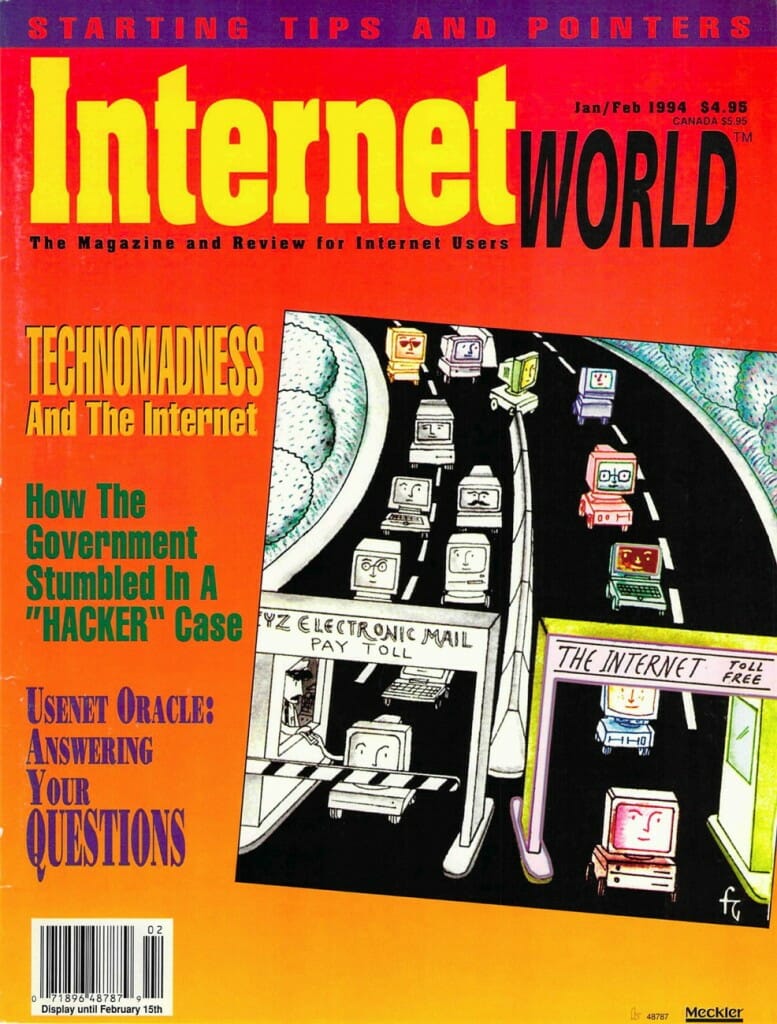
OUR NEXT GUEST IS STEVE ROBERTS, “THE BIKE GUY.” IN CASE BY SOME CHANCE YOU HAVEN’T HEARD OF STEVE BEFORE (“WHAT? <GRIN>” STEVE REPLIED WHEN I SUGGESTED THE POSSIBILITY TO HIM), HE’S THAT TALL GUY WHO OWNS AND RIDES A RECUMBENT BICYCLE CALLED BEHEMOTH THAT LETS HIM SIMULTANEOUSLY CRUISE PHYSICAL REALITY AND LIVE/WORK VIA CYBERSPACE, NAMELY, THE INTERNET.
THE MARCH OF TECHNOLOGY HAS MADE SOME OF WHAT STEVE DOES AVAILABLE TO MORE OF US, BUT HE WAS AMONG THE FIRST TO ACHIEVE WHAT MANY OF US LONG FOR — OR FEAR — THE ABILITY TO BE “ON THE NET” NO MATTER WHERE WE ARE OR WHAT WE’RE DOING. HE’S NOW WORKING ON A WATER-GOING VEHICLE (NO INDICATION OF PUTTING A HANG-GLIDER ON THE NET —YET).
HERE’S STEVE TO TALK SOME ABOUT HOW THE INTERNET HAS BECOME PART OF HIS REALITY ON THE GO. — DPD
“So, where do you call home?” someone always asks me during those on-the-street encounters around the bike. “Where do you actually live?”
“In the Internet,” I answer, usually receiving a blank look in response. “You know… online. My home is the Net.” By this time, the average questioner is squirming uncomfortably, unsure whether I am some kind of proselytizing nutcase or simply another computer nerd on the verge of launching into an obscure technical lecture.
It can take quite a bit of explanation to convey the once-alien notion that with enough connectivity, your physical location can become irrelevant. It is an idea that calls some very basic definitions into question — most centrally, what is home?
Think about it. What is it about a familiar setting that provides all your essential stability and support resources? Is it the building? The fixed mailing address? Proximity to your work? Familiar people and nearby stores? A place to unpack your belongings, stack up magazines, find things easily, and accumulate a lifetime of memories? And if home really is all these things, how can the notion of living in the Internet make any sense at all?
Ignoring the storage of physical objects and a guaranteed place to sleep, consider four of the major requirements of “home”: familiar friends nearby, a place to work on your projects, a base for your daily business or employment, and proximity to comfortable local hangouts and other resources.
These, for many people, can all be viewed as various forms of information… which has no mass and moves at the speed of light. It should thus be possible to access that information from anywhere without any disruptive effects related to your physical movement around the planet.
Furthermore, if your mode of physical movement satisfies your tangible needs (like a place to accumulate interesting objects, comfortable sleeping quarters, visceral fun, and whatever), then you are capable of becoming a technomad: physically rootless but wired into your electronic home in the Internet.
Using my ten years of technomadics as an example, let’s look at those four areas a little more closely…
FRIENDS
This one’s easy! If a major component of “home” is a stable circle of friends, then the Internet is the best one I’ve ever had — better even than my eight years of traditional home ownership in Midwestern suburban neighborhoods. On the net, friendships span the globe. (As I’m writing this, I’m engaged in a late-night e-mail exchange with a fellow named Tim in Austria who wants to join the flotilla of aquatic technomads.)
Physical location is meaningless, and that means that a circle of friends is no longer constrained by the random influences that determined their latitude and longitude. Relationships develop because brains are compatible, not because the parties happen to live in the same town.
In addition, relationships online develop without regard to physical appearance, and that has all sorts of interesting cultural implications. Age, sex, weight, disabilities, facial topography, pigmentation — none of these things makes a bit of difference when two brains are linked through the vapors of the net. The old biases that most people grew up with are now as irrelevant as the obsolete national borders between us.
Given all this, as well as the interesting intellectual demographics of Dataspace, it’s no surprise that most online denizens consider the Net a central social resource. It is for me, certainly, with romance swirling through my daily e-mail and some of the most significant relationships in my life maintained exclusively online, often with people I’ve never met face to face. When I meet someone new in physical space and realize that we should remain in touch, I quickly warn them that I cannot maintain an effective relationship with anyone who is not online — the meager bandwidth of occasional paper mail and the annoyance of telephone tag are just too inhibiting.
Checking my archives, I see one mail file of nearly 300 saved letters exchanged with one person over the past six months — and those were only the good ones! At least twice that number were erased… the quick hellos, acknowledgments, ephemeral news updates, and so on.
What is the information content of all this? Everything that makes up a friendship: mutual exploration, argument, shared humor, moments of longing, late-night meanderings, news of life developments — in short, everything that people talk about.
Certainly, this is an important component of “home,” and my location during those 300 letters (and thousands of others besides) ranged over some 20,000 miles of touring America during the past year… wandering my neighborhood, dropping in on friends for evenings of wide-bandwidth multisensory interaction.
PROJECTS
But it takes more than friendships to keep your life running smoothly. Hobbies, passions, grand dreams, book writing, research, building new toys — all sorts of activities involve digging for information, making purchase decisions, and collaborating with others who share similar interests.
At the moment, I am designing my next technomadic platform — a small trimaran called the Microship. This is an incredibly complex project, and I’m integrating resources from all over the planet to help define the proper balance of hull geometry, sail plan, solar power, hatch placement, freeboard, connectivity tools, navigation resources, and countless other things.
Daily, I turn to the net for help: posting questions to rec.boats and other newsgroups, updating collaborators with daily e-mail reports, researching relevant literature online, and chatting with potential traveling companions. There are people out there who send me detailed commentary on hull fabrication methods or fine points of navigation… in effect, collaborating with me across the miles, sharing their knowledge to help build something they may never see. Yet, I don’t even know where they live or what they look like.
Of course, it’s still nice to have local help willing to get their hands dirty, but information is a critical resource and requires global scale. I’ve shared writing projects, gotten help with design or repair jobs, and tracked down obscure technical articles — usually within a few hours of sensing the need. Life offline was never as effective.
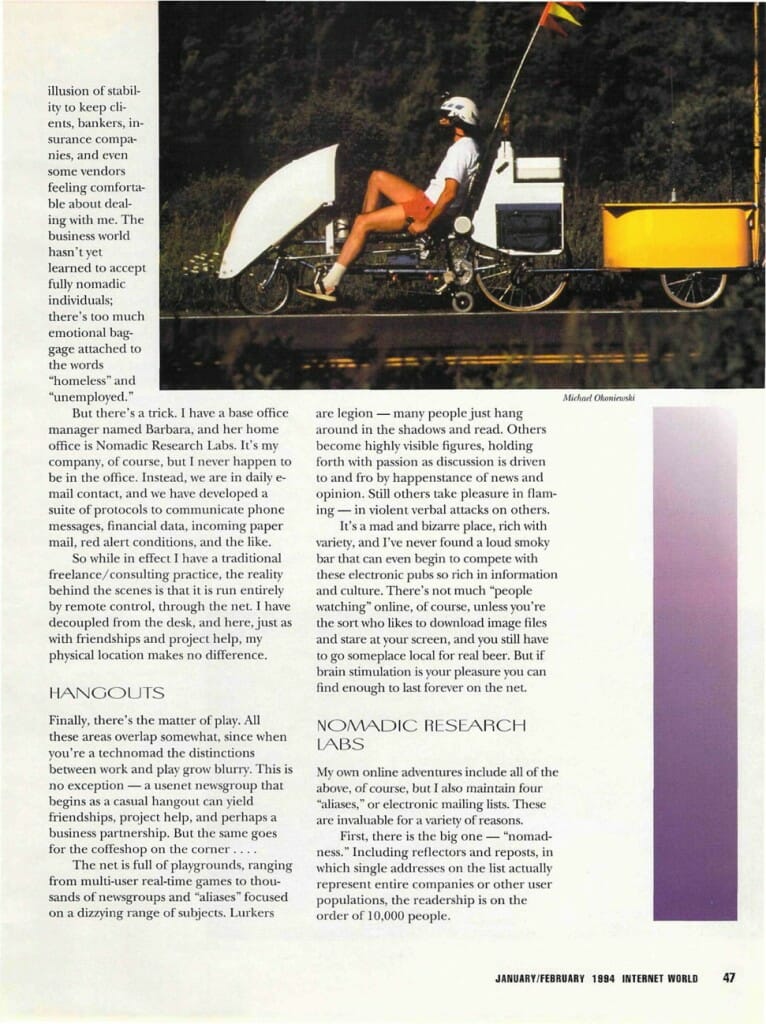
BUSINESS
This is what most people grasp first about online resources — the numbers and business communication tools. But going nomadic adds another twist to it, and a critical one: somehow, I have to generate the illusion of stability to keep clients, bankers, insurance companies, and even some vendors feeling comfortable about dealing with me. The business world hasn’t yet learned to accept fully nomadic individuals; there’s too much emotional baggage attached to the words “homeless” and “unemployed.”
But there’s a trick. I have a base office manager named Barbara, and her home office is Nomadic Research Labs. It’s my company, of course, but I never happen to be in the office. Instead, we are in daily email contact, and we have developed a suite of protocols to communicate phone messages, financial data, incoming paper mail, red alert conditions, and the like.
So while in effect I have a traditional freelance/consulting practice, the reality behind the scenes is that it is run entirely by remote control, through the net. I have decoupled from the desk, and here, just as with friendships and project help, my physical location makes no difference.
HANGOUTS
Finally, there’s the matter of play. All these areas overlap somewhat, since when you’re a technomad the distinctions between work and play grow blurry. This is no exception — a Usenet newsgroup that begins as a casual hangout can yield friendships, project help, and perhaps a business partnership. But the same goes for the coffee shop on the corner ….
The net is full of playgrounds, ranging from multi-user real-time games to thousands of newsgroups and “aliases” focused on a dizzying range of subjects. Lurkers are legion — many people just hang around in the shadows and read. Others become highly visible figures, holding forth with passion as discussion is driven to and fro by happenstance of news and opinion. Still others take pleasure in flaming — in violent verbal attacks on others.
It’s a mad and bizarre place, rich with variety, and I’ve never found a loud smoky bar that can even begin to compete with these electronic pubs so rich in information and culture. There’s not much “people watching” online, of course, unless you’re the sort who likes to download image files and stare at your screen, and you still have to go someplace local for real beer. But if brain stimulation is your pleasure you can find enough to last forever on the net.
NOMADIC RESEARCH LABS
My own online adventures include all of the above, of course, but I also maintain four “aliases,” or electronic mailing lists. These are invaluable for a variety of reasons.
First, there is the big one — “nomadness.” Including reflectors and reposts, in which single addresses on the list actually represent entire companies or other user populations, the readership is on the order of 10,000 people.
Every now and then, I write an article about the current status of the bike or boat project, recent adventures on road or water, or even philosophical observations about the nomadic life in general. These are posted to the world and archived in a couple of servers Out There so that people who missed them the first time can download them later.
The interesting twist here is that this is the same text I publish in a quarterly print newsletter called The Nomadness Report, which costs $15 per year. I’ve been asked why I freely give away the same material to people on the net, yet charge for it on paper. Aside from the obvious fact that it costs real money to put out a print publication, the reason I publish it for free online is simple: soft dollars.
It’s a wonderful thing: those 10,000 or so people are an immense resource of ideas, places to stay, and encouragement. Last year, when I took off around the United States in the diesel mothership to do speaking engagements, more than half of the bookings resulted from a single comment in one of those online postings. Likewise, many of the homes I visit are those of online subscribers.
And when I need to know something — like a recent question about still-video image formats — all I have to do is mention it in a story and the letters come pouring in. These interactive experiences would never happen with the print edition.
My second alias is “technomads” — an online discussion group focused on the tools and techniques of nomadic connectivity. Unlike the nomadness list, which is for one-way publishing only, technomads is an active forum for anyone who wishes to speak… and about 300 people are involved. I’m actually rather quiet here, just watching the periodic flurries of activity caused by the occasional interesting question about chord keyboards or cellular modems, every now and then interjecting a comment or two.
Third, I have a very small list of about fifteen people called “flotilla” — a place for possible traveling companions to chat and get to know each other.
(Over time, if my dream of an aquatic nomadic community actually develops, this will be the communication link that we will use to handle all the logistical details. In the meantime, we’re tentatively exploring each other and trying to figure out how a bunch of individuals of diverse skills and dreams might coexist as a traveling group of networked small boats.)
And fourth, there’s MS-Status, the daily postings to those involved in the Microship project I have a team of engineering students at the University here, as well as a few professors, consultants, and friends who are helping in various ways to build this complex system.
What better way to keep us all aware of each other’s work than to publish a detailed daily report? It includes discussion of minute design issues, logs incoming product literature and books, reports on developments with sponsors, and forms a complete project history that is archived and printed monthly as a resource for newcomers and raw material for the eventual book.
The thought of managing a project of this scope offline, with this many people involved, is chilling. Somehow, people coped in the old days, and they have my respect; somehow, people even cope now without a net connection: I’m occasionally astounded to find high-tech companies who are not online — living anachronisms, charging ahead through an information vacuum, out of touch with the world outside but getting away with it on the strength of their skills, unique qualities, and traditional clientele. As time passes, though, this will become more and more difficult.
THE NOMADIC CONNECTION
With all this talk about nomadic connectivity and virtual home in the net, I should make a few comments about the connection itself. After all, when most people think of going online, they think of modems and phone lines — or, for the lucky ones, a dedicated high-speed network connection to a workstation.
The Macintosh PowerBook 170 I’m using to write this is wired via AppleTalk to the UCSD network, which is in turn linked tightly to the Internet. But this luxury only exists while I’m sitting in my temporary Microship lab in the Engineering Building. When I’m Out There, on the road or in the water, the connection is not quite so robust.
The obvious path, and often a perfectly acceptable one, is cellular modem. I’ve used a variety of these products, and as long as I happen to be within radio range of a cellular phone market I can connect at up to 10K baud. I’ve pushed this to over 100 miles with a 6-element Larsen yagi wide-band antenna optimized for the cellular band. Unfortunately, however, this is not always available when wandering in some of the more interesting parts of the world.
BEHEMOTH’S major Internet link is a custom implementation of the Qualcomm OmniTRACS satellite terminal. A 14 GHz azimuth-tracking antenna in a 1-foot radome on the back of my trailer locks onto the GTE GSTAR satellite, with elevation tracking unnecessary in the United States due to a 40-degree beam height centered 40 degrees above the horizon. (An antenna and ROM change will let this work in the Pacific Rim, Australia, or Europe.)
On the bike’s console, a Macintosh runs Eudora (an excellent e-mail front end that uses POP, or Post Office Protocol) [Note: Macintosh and Windows versions of Eudora are available as shareware (do an archie search); Qualcomm has also recently started introducing commercial versions (with documentation, support, and more features) — DPD] as well as some special code that emulates a POP server while handling communication with the satellite terminal. At Qualcomm’s site in San Diego, a SPARCstation completes the link, transferring mail between the satellite and the Internet.
The result is a transparent e-mail path that works from my moving bicycle anywhere in or near North America — and this will be implemented on the new boat as well.
There are other methods as well. RadioMail, one of the services from Geoff Goodfellow’s RadioMail Corporation (San Mateo, California), uses small cellular-like modems and laptop or palmtop computers, though at the moment service is limited to metropolitan areas. Inmarsat’s Standard C satellite service now supports an e-mail gateway and has the significant advantage of working globally, but both the connect time and the terminal are expensive.
All sorts of schemes are underway to use new low-earth-orbit satellites, cram data into the interstices of existing cellular transmissions, or take advantage of terrestrial packet data communication methods developed over the past decade by amateur radio operators. More is coming…
No matter what the communications path, the trend is toward mobility. The word is out that it’s no longer necessary to remain chained to your desk. Whether we’re about to see a whole population of technomads is yet unknown, but I wouldn’t be surprised. The age-old fantasy of freedom from the daily grind is now easily within reach if you can relocate the major components of your home to the net.
As to the rest, like having a place to sleep and stockpile your library of books and CDs… well, you just need to choose the right vehicle!
Cheers from the Net,
Steve Roberts


